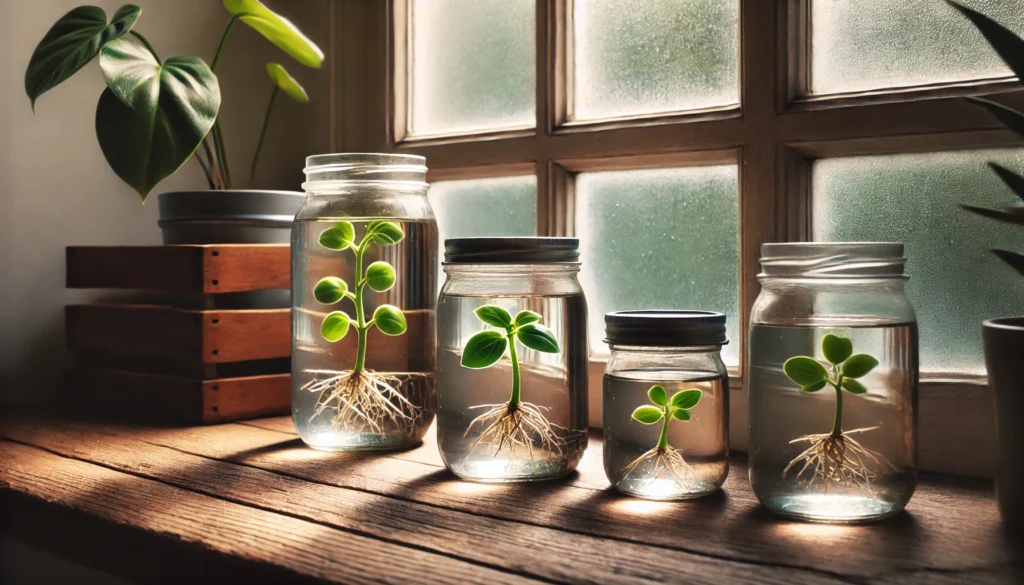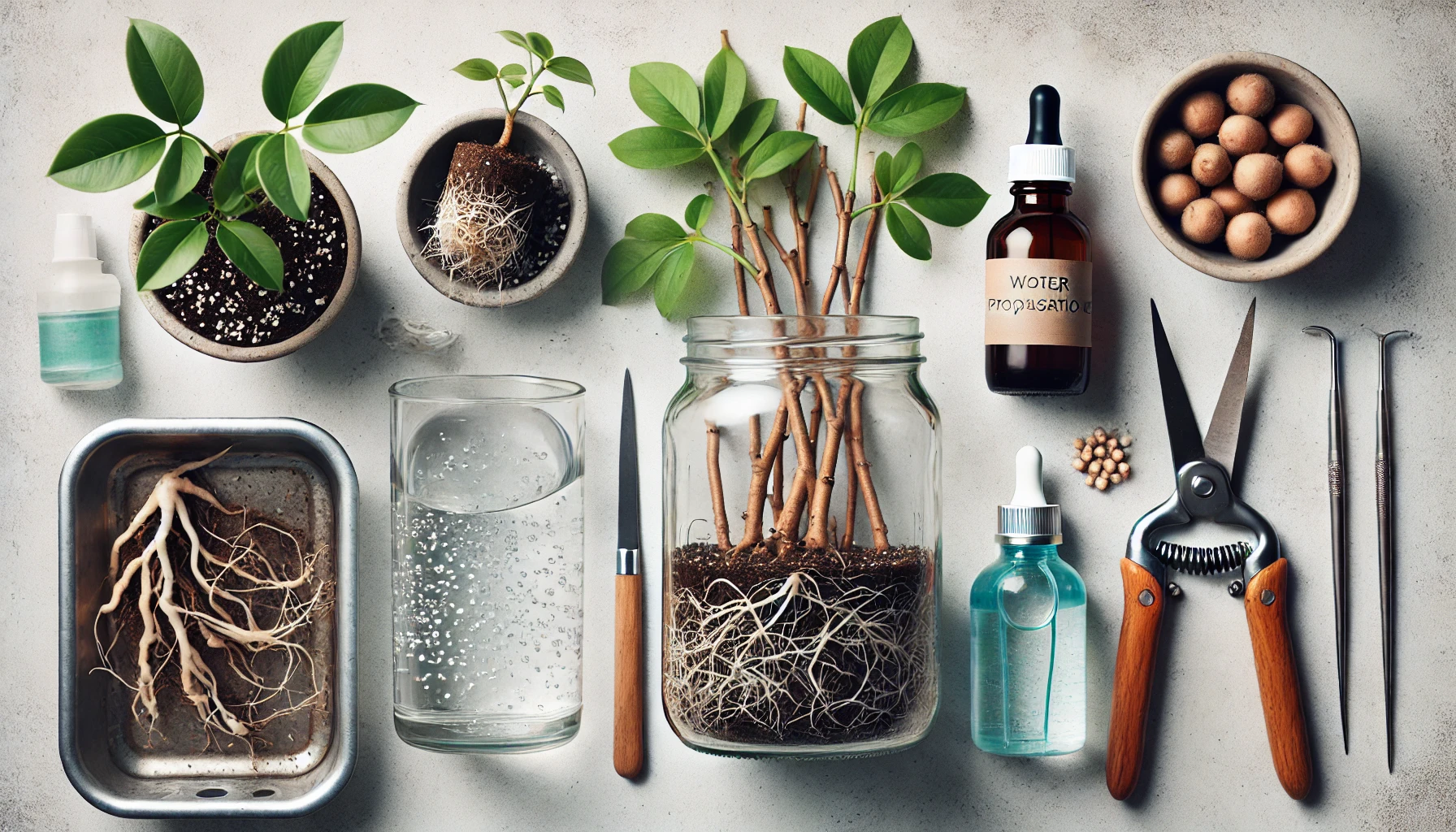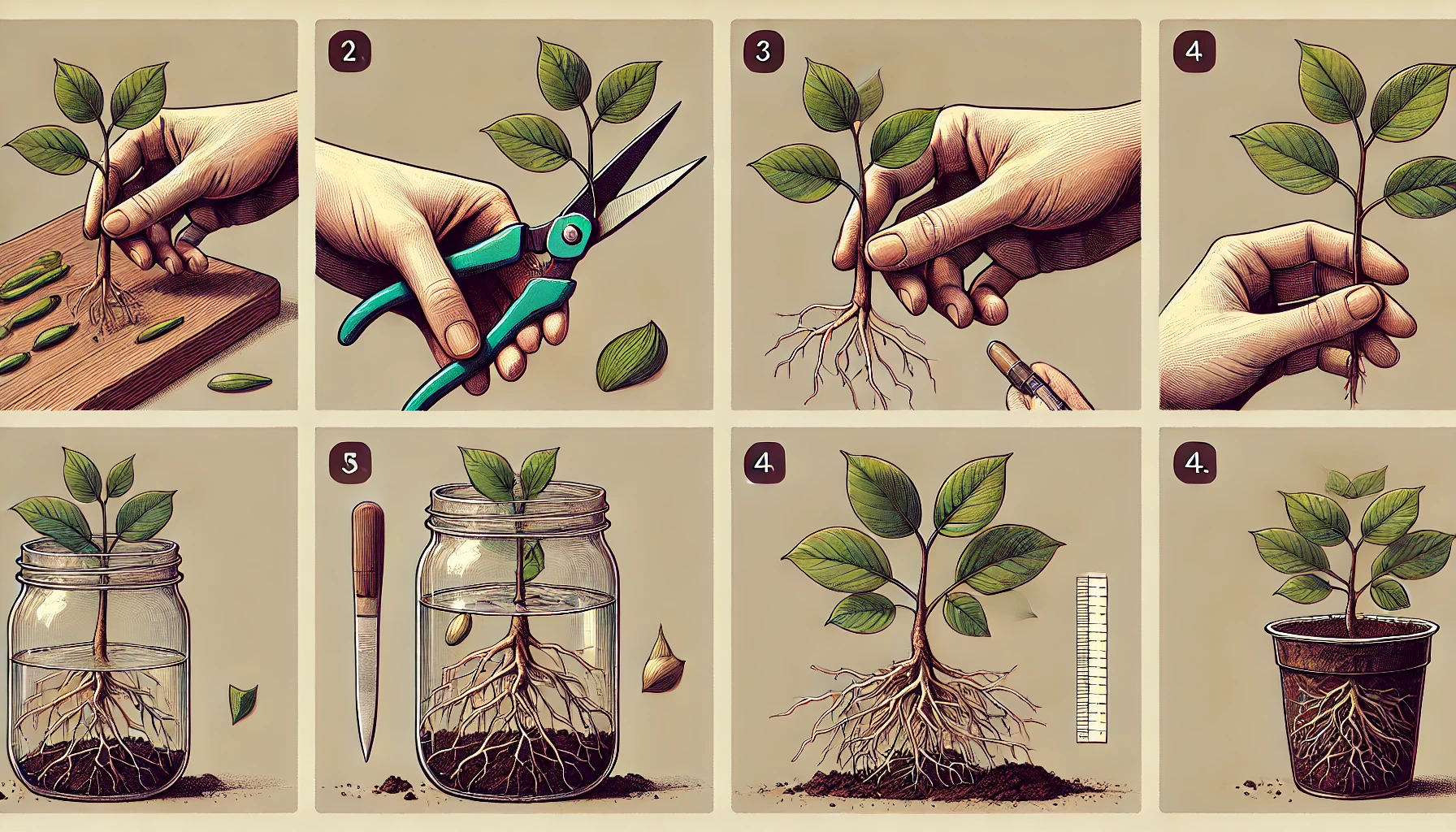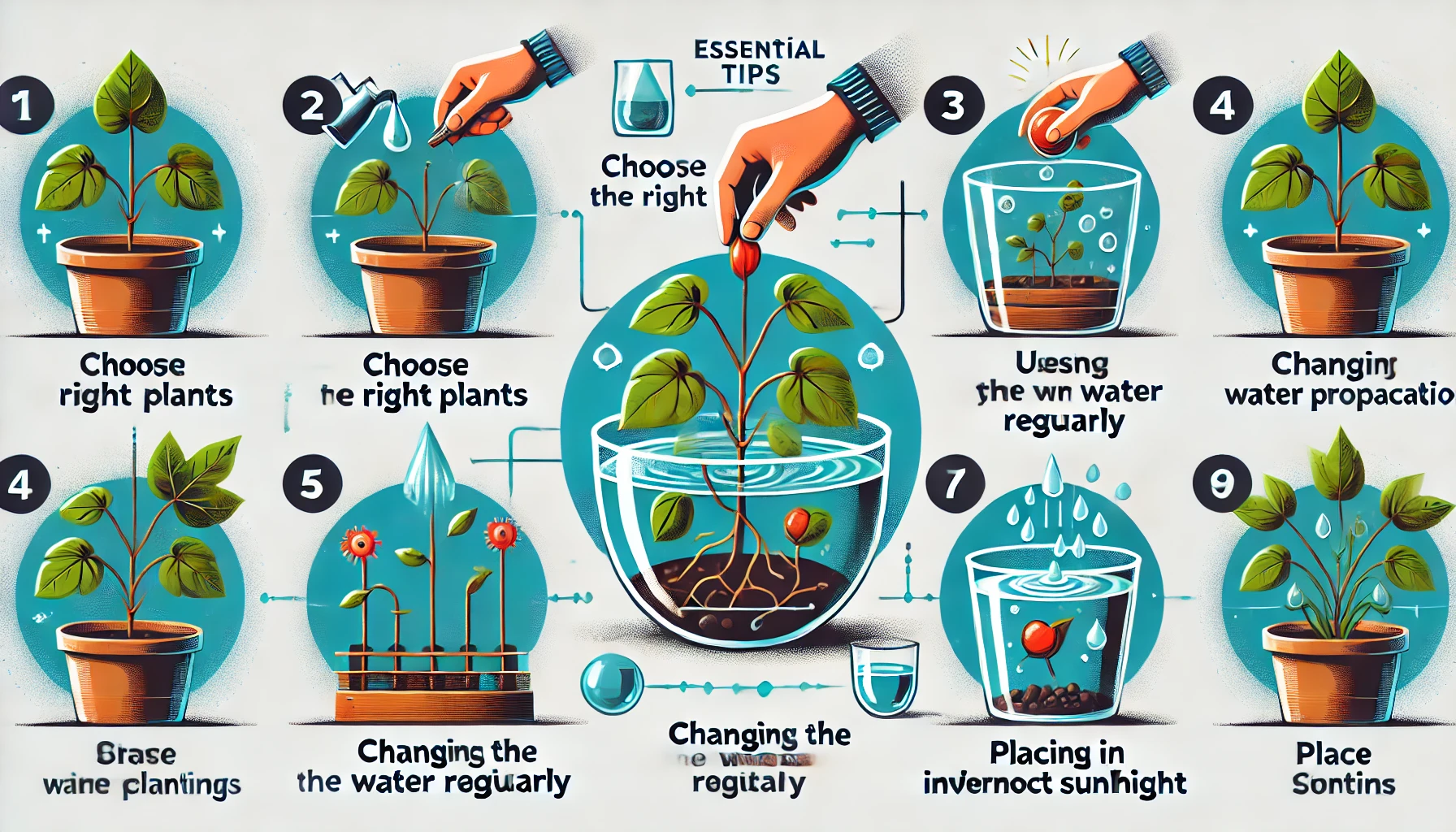
How to Propagate Plants in Water: A Simple Guide for Beginners
Have you ever wondered how to propagate plants in water and enjoy a thriving garden without needing complex tools or techniques? Propagating plants in water is a simple, cost-effective method that anyone can master, even if you’re just starting your gardening journey. Whether you’re looking to grow new plants from cuttings or expand your indoor plant collection, this beginner-friendly guide will walk you through the easy steps to propagate plants successfully. In just a few simple steps, you can have your very own water-rooted plants thriving and ready for transplanting. Let’s dive in and discover how to propagate plants in water effortlessly!
Table of Contents
ToggleWhat is Plant Propagation in Water?
Plant propagation in water is a simple and effective method of growing new plants by using water as the medium for root development. This process involves taking a cutting from a healthy plant and placing it in water until roots begin to form, after which the new plant can be transferred to soil or kept in water for continued growth.

This technique is particularly popular for houseplants, such as pothos, philodendrons, and spider plants, and is appreciated for its simplicity and low cost. Propagating in water allows you to observe the root growth, giving you a clear sign of progress. Plus, it’s an eco-friendly way to expand your plant collection.
In essence, plant propagation in water provides a straightforward approach to creating healthy new plants with minimal effort. Whether you’re a beginner or experienced gardener, this method is a great way to multiply your greenery and enjoy the beauty of new growth.
Why Propagate Plants in Water?
Propagating plants in water offers several advantages, making it a popular method among gardeners, both beginners and seasoned experts. Here are some key reasons why this approach is so effective:

Easy Monitoring
When you propagate in water, you can easily monitor root development. You can observe the roots grow and ensure the plant is healthy before transferring it to soil. This allows for quick intervention if something goes wrong, such as algae buildup or root rot.
Promotes Faster Root Growth
Water provides a stable, consistent environment for roots to grow. Many plants form roots faster in water compared to soil, especially when they have adequate light and warmth. This can shorten the time needed to propagate the plant and get it ready for transplanting.
Space-Efficient
Water propagation doesn’t require a lot of space. You can use small containers like jars, glasses, or even cups, making it perfect for those with limited space. It’s also an ideal solution for urban gardeners or people living in apartments.
No Need for Special Equipment
Unlike some soil-based propagation methods, water propagation doesn’t require fancy tools or equipment. All you need is a container, water, and a plant cutting. This simplicity makes it accessible for anyone, regardless of their gardening experience.
Ideal for Certain Plants
Some plants, like pothos, ivy, or philodendrons, naturally root better in water. For these species, water propagation is the most reliable and efficient method, giving you a higher success rate compared to soil propagation.
Hassle-Free Transplanting
When roots form in water, transplanting to soil is smoother and less stressful for the plant. The roots are already established, making them less likely to experience transplant shock when placed in soil.
In conclusion, propagating plants in water is a simple, effective, and accessible method for many plant lovers. Whether you’re looking to expand your collection or experiment with new plants, this approach is a great way to start.
The Essential Supplies for Water Propagation
Water propagation is a simple and effective way to grow new plants, but having the right supplies is key to ensuring success. Here are the essential items you’ll need:

Clear Glass Containers
Choose clear glass jars, vases, or cups to hold your plant cuttings. Clear containers allow you to easily monitor the root development process. They also provide enough light for the roots to grow effectively. A small glass jar or mason jar works perfectly for most plants.
Healthy Plant Cuttings
Select healthy cuttings from mature plants with no signs of disease. The cutting should include at least one node (the area where leaves sprout) to encourage root growth. Trim the cutting just below a node to ensure success.
Water
Use clean, room-temperature water for propagation. Tap water works fine for most plants, but if your tap water is high in chlorine or fluoride, opt for distilled or filtered water. Change the water every few days to prevent stagnation and keep your cuttings healthy.
Rooting Hormone (Optional)
Rooting hormones can speed up the rooting process, though they are not necessary for all plants. If you choose to use one, apply it to the cut end of your plant cutting before placing it in water. This is especially helpful for harder-to-root plants.
A Sunny Spot
Once your cuttings are placed in water, ensure they are in a location with bright, indirect sunlight. A windowsill works great for this purpose. Avoid direct sunlight, which can overheat the water and damage the plant.
With these simple supplies, you’ll be on your way to successfully propagating your plants in water. Just remember to be patient and monitor your cuttings regularly for signs of growth!
Step-by-Step Guide to Propagating Plants in Water
Propagating plants in water is a simple and effective way to grow new plants without soil. Follow these easy steps to successfully propagate your favorite plants:

Choose the Right Plant
Some plants root easily in water, including pothos, philodendron, and coleus. Select a healthy plant with a stem that has at least one node (the small bump where roots grow).
Cut the Stem
Using clean, sharp scissors, cut a 4-6 inch stem below a node. Ensure the cutting has at least one or two nodes submerged in water.
Prepare the Container
Fill a clear glass or jar with fresh, clean water. The container should be tall enough to submerge the nodes but allow the top of the stem to remain above the water.
Place the Cutting in Water
Submerge the stem in the water, making sure the node is fully underwater. Keep the container in a bright, indirect light area, away from direct sunlight to avoid algae growth.
Change the Water Regularly
Refresh the water every 3-5 days to keep it clean and oxygenated. This helps prevent bacteria and keeps the cutting healthy.
Wait for Roots to Grow
Within 2-4 weeks, you should see tiny roots developing from the node. Once the roots are 2-3 inches long, your cutting is ready for planting in soil or can be kept in water indefinitely.
Transfer to Soil (Optional)
If you prefer soil over water, carefully transplant your rooted cutting into a small pot with well-draining soil. Water the new plant regularly until it establishes itself.
By following these simple steps, you can easily propagate your favorite plants in water, expanding your collection with minimal effort!
Common Mistakes to Avoid When Propagating in Water
Propagating plants in water can be a rewarding and simple way to grow new plants, but it’s important to avoid a few common mistakes to ensure success. Here are key pitfalls to watch out for:
Using Dirty Water
Always start with clean water. Contaminated or stagnant water can introduce bacteria or mold that will harm the plant. Change the water regularly, at least every 2-3 days, to keep it fresh and oxygenated.

Not Providing Enough Light
While water propagation doesn’t need direct sunlight, lack of light can slow down root development. Ensure your cutting gets bright, indirect light. Too little light will result in weak roots and stunted growth.
Incorrect Water Levels
Submerge only the bottom part of the stem in water. Too much water can lead to rotting, while too little can dry out the cutting. Maintain just enough water to cover the nodes where roots are expected to form.
Overcrowding Containers
Don’t place too many cuttings in one container. Overcrowding leads to competition for nutrients and light, affecting root growth. Use separate containers for each cutting to give them ample space to grow.
Ignoring Root Growth Signs
Be patient, but also be aware of the signs of healthy root growth. Once roots are about 1-2 inches long, it’s time to transplant into soil. Leaving the cutting in water for too long can stunt its growth or make it dependent on water
By avoiding these mistakes, you’ll ensure a more successful propagation process, leading to healthy new plants ready for planting in soil or transferring to larger containers.
Transplanting Water-Propagated Plants
Transplanting your water-propagated plants into soil is a crucial step in ensuring they thrive. Here’s how to do it correctly:
Wait for Strong Roots
Before transplanting, make sure your cutting has developed healthy roots—ideally 1-2 inches long. Weak or underdeveloped roots may struggle to adapt to soil, leading to transplant shock.

Choose the Right Soil
Use well-draining potting soil, preferably one that’s rich in organic matter. This ensures the roots won’t sit in waterlogged soil, which can cause rot. A mix designed for indoor plants or succulents works well for most varieties.
Prepare the Pot
Choose a pot with drainage holes to prevent water from accumulating at the bottom. Fill it with soil, leaving enough room at the top for the plant’s root ball.
Gently Remove the Plant from Water
Carefully take the cutting from the water, handling the roots gently to avoid breaking them. Be mindful of any excess water still on the roots—pat them lightly with a paper towel if needed.
Planting
Place the cutting into the prepared pot and fill around the roots with soil. Firm the soil gently to eliminate air pockets, but avoid packing it too tightly. Ensure the roots are well-covered but the stem isn’t buried too deep.
Water and Acclimate
After transplanting, water the plant thoroughly to help it settle into the new soil. Keep the plant in a shaded spot for a few days to reduce stress. Once it’s acclimated, move it to a location with appropriate light.
By following these simple steps, your water-propagated plants will have a smooth transition to soil and continue to grow strong and healthy.
Tips for Success in Water Propagation
To ensure your water propagation efforts are successful, here are some expert tips to follow:
Choose the Right Plants
Not all plants are ideal for water propagation. Focus on easy-to-root varieties like pothos, ivy, and spider plants. These plants tend to develop strong roots in water and are perfect for beginners.

Use Clean, Clear Containers
Use clear glass or plastic containers to easily monitor root growth. Clean the container thoroughly before use to avoid introducing any bacteria or mold to the water.
Keep Water Fresh
Change the water every 2-3 days to prevent it from becoming stagnant. Fresh water helps the cutting stay healthy and encourages quicker root development.
Place in Indirect Light
Ensure your cuttings get plenty of indirect sunlight. Too much direct sunlight can cause algae to form, while too little light can slow down the rooting process. A windowsill with filtered light is usually perfect.
Ensure Proper Water Depth
Submerge only the bottom 1-2 inches of the cutting in water. Too much water can cause rot, while too little won’t provide enough moisture for root growth. Keep an eye on the water level and adjust as necessary.
Be Patient
Water propagation can take time. Some cuttings might develop roots in a week, while others can take a month or more. Stay patient and let nature do its work!
Transplant at the Right Time
Once your roots reach around 1-2 inches, it’s time to move the cutting into soil. Waiting too long can lead to weak or overgrown roots, making the transition to soil difficult.
In conclusion, learning how to propagate plants in water is an incredibly rewarding and beginner-friendly way to expand your plant collection. With just a few simple steps, you can watch your cuttings grow roots and transform into thriving new plants. Not only is it a cost-effective and straightforward method, but it also offers a great way to connect with your plants and enjoy the satisfaction of nurturing them from start to finish. Remember, patience is key, and with time, you’ll become more skilled at recognizing which plants thrive best in water propagation. So, grab a cutting, a container, and some fresh water—your new plant-growing adventure is just beginning! Happy propagating!
Frequently Asked Questions(FAQ)
How long does it take for roots to form when propagating plants in water?
The time it takes for roots to form can vary depending on the type of plant, but generally, it takes anywhere from 2 to 4 weeks. Some plants may root faster, while others could take a little longer. Be patient and ensure the cutting stays healthy by changing the water regularly.
Can I propagate any plant in water?
While many plants can be propagated in water, not all are suitable. Common plants that propagate well in water include pothos, ivy, coleus, and philodendron. Plants that are harder to propagate, like succulents or cacti, typically do better when propagated in soil.
Can I use tap water for propagating plants?
Tap water can be used for propagating plants, but it’s best to let it sit for 24 hours to allow chlorine to dissipate. If possible, use distilled or rainwater for the best results, as it’s free from chemicals that might harm the cutting or slow down root development.
How can I tell if my cutting is ready to be planted in soil?
Once the roots on your cutting are about 1-2 inches long, it’s generally a good time to transplant it into soil. Be sure to check that the roots look healthy and white—if they’re brown or mushy, the cutting may need more time in water.
Do I need rooting hormone when propagating plants in water?
Rooting hormone is not necessary for propagating in water, although it can sometimes speed up the rooting process. For beginners, it’s perfectly fine to propagate without it and still see success. Just ensure the cutting is healthy and the water is clean.
What should I do if my plant cutting isn’t growing roots?
If your cutting isn’t developing roots, check that it’s placed in clean water and is getting enough indirect light. You may also want to trim the cutting slightly to ensure you’re working with fresh, healthy material. If necessary, you can try using a rooting hormone to encourage growth.
Can I propagate plants in water year-round?
Yes, you can propagate plants in water year-round. However, during the colder months, you might need to ensure the cutting is kept in a warm spot, as cooler temperatures can slow down the rooting process.
How often should I change the water when propagating in water?
It’s best to change the water every 2-3 days to keep it clean and free from mold or algae buildup. Regularly replacing the water helps ensure your cutting remains healthy and encourages faster root growth.
